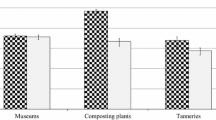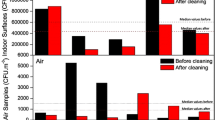Abstract
Species of theAspergillus ochraceus group were most abundant in the air of a coffee curing works of the seventeen environments studied at Mysore. They also occurred in large numbers in coffee dust, husk samples, sorghum and paddy. Incubating at room temperature (20–25°C) was found most suitable for enumeration of these species. Only 6.6% of the air-borne isolates of the group produced ochratoxin-A. A. ochraceus was the most common species of the group isolated from air and also yielded a greater proportion of toxic isolates.
Similar content being viewed by others
References
Baraki-Golan R 1961 Air-borne fungi in packing houses for citrus fruits;Bull. Res. Counc. Israel D10 135–141
Christensen M 1982 TheAspergillus ochraceus group: Two species from western soils and a synoptic key;Mycologia 74 210–225
Ciegler A 1972 Bioproduction of ochratoxin A and Penicillic acid by members of theAspergillus ochraceus group;Can. J. Microbiol. 18 613–636
Harwig J 1974 Ochratoxin A and related metabolites; in:Mycotoxins (ed.) Purchase (Amsterdam; Elsevier) pp.345–367
Hudson H J 1969 Aspergilli in the air-spora at Cambridge;Trans. Br. Mycol. Soc. 52 153–159
Jayaprakash K B and Ramalingam A 1981Aspergillus fumigatus in the air of working environments at Mysore;Indian J. Bot. 4 17–23
Kramer C L, Pady S M and Rogerson C T 1960 Kansas aeromycology V:Penicillium andAspergillus;Mycologia 52 545–551
Lillehoj E B, Aalund O and Hald B 1978 Bioproduction of (14C) ochratoxin A in submerged culture;Appl. Environ. Microbiol. 36 720–723
Nesheim S, Hardin N F, Francis O J and Langham W S J 1973 Analysis of ochratoxin A and B and their esters in barley using partition and thin layer chromatography. I. Development of the method;J. Assoc. Off. Anal. Chem. 56 817–821
Novey H S and Wells I D 1978 Allergic bronchopulmonary aspergillosis caused byA. ochraceus;Am. J. Clin. Pathol. 70 840–843
Pandey K K 1979 Variation in the air mycoflora over a fish market and a field.Acta bot. Indica 7 167–170
Peckham J C, Doupnik B and Jones O H 1971 Acute toxicity of ochratoxins A and B in chicks;Appl. Microbiol. 21 492–494
Raper K B and Fennell D I 1965The genus Aspergillus; Huntington (New York: R E Krieger Pub. Co.) p. 686
Rati E, Basappa S C, Sreenivasamurthy V, Ramesh H P, Ramesh B S and Singh G B 1981 The Synergistic effect of aflatoxinB 1 and ochratoxinA in rats;J. Food Sci. Technol. 18 176–179
Rati E and Ramalingam A 1976 Air-borne aspergilli at Mysore;Aspects Allergy Appl. Immunol. 9 139–149
Samson R A 1979 A compilation of the Aspergilli described since 1965.Studies in mycology 18 1–38
Thomas A R 1977 The genusAspergillus and biodeterioration; InGenetics and physiology of Aspergillus. (ed) Smith and Pateman (London; Academic Press) pp. 453–479
Author information
Authors and Affiliations
Rights and permissions
About this article
Cite this article
Jayaprakash, K.B., Ramalingam, A. Hazardous species ofAspergillus ochraceus group in the air of working environments at Mysore. Proc. Indian Acad. Sci. 92, 387–392 (1983). https://doi.org/10.1007/BF03052987
Received:
Revised:
Issue Date:
DOI: https://doi.org/10.1007/BF03052987




